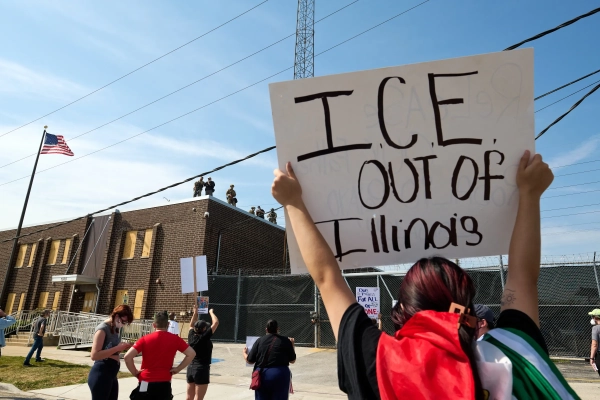“`html 
When an armed individual discharged a firearm at an immigration center in Dallas the previous week, resulting in the death of a minimum of one immigrant detainee, it aligned with a current trend of intensifying friction — and brutality — that has increasingly characterized President Donald Trump’s large-scale deportation campaign.
At the core of this escalating duress is a specific entity: the U.S. Immigration and Customs Enforcement, empowered to implement Trump’s anti-immigrant regulations nationwide.
The Republican reaction to the Dallas incident was consistent: They denounced it as the newest instance of left-leaning inspired aggression toward law enforcement. Politicians, advocates, and analysts quickly highlighted it as proof that Democrats were directly “instigating” antagonism against ICE, assisting criminals, and obstructing Trump’s objectives. “This violence stems from Radical Left Democrats continuously vilifying Law Enforcement, advocating for ICE’s dismantlement, and equating ICE Agents to ‘Nazis,’” Trump declared on Truth Social. The White House subsequently issued a compilation of Democrats’ critique of ICE, labeling their statements “a call to arms for violence.”
In contrast, Democratic reactions were fractured. A majority of national Democrats have chosen to remain silent — encompassing candidates competing in closely contested electoral races like Sen. Sherrod Brown in Ohio, ex-Gov. Roy Cooper in North Carolina, and progressive figures in Congress. House and Senate leaders condemned violence directed at law enforcement, whereas Texas Democrats stated, “no individual — whether uniformed, civilian, or immigrant — should be subjected to senseless violence.”
Numerous explanations exist for why more Democrats haven’t spoken out — several particulars remain unknown. Nevertheless, this divergence in responses underscores a more profound schism between the parties and among Democrats. Republicans are fully supportive of ICE, while Democrats are gradually recognizing the need to determine their stance and propose solutions regarding the agency.
This discussion is poised to intensify throughout the midterms and leading up to 2028. Americans are exhibiting increased favorability toward immigration and increased negativity toward ICE. Segments of the Democratic base are eager for their leaders to challenge Trump’s drive for extensive deportations. Furthermore, it is becoming increasingly evident that the matter of how to address ICE, especially if and when Democrats regain control, is overshadowing the party’s leadership and potential 2028 contenders.
The preceding weeks have also revealed a growing quantity of instances indicating apparent overreach by ICE agents: widely shared videos depicting aggressive handling of citizens, detaining or antagonizing Democratic politicians — such as those involving a mayor and congresswoman in New Jersey, as well as a mayor and congressional candidate in Illinois — and street patrols within major metropolitan areas. The outcome? The discourse regarding ICE among Democrats is projected to become increasingly intense.
Related
- Trump’s legal action against a Democratic legislator constitutes a preliminary trial for authoritarian governance
The justification for bypassing the glaring ICE presence
Following Kamala Harris’s defeat last year, the accepted notion has become ingrained: Americans favored Trump and the GOP over Democrats partially due to apprehension and discontent with the ruling party’s management of the economy, but also due to its shift leftward on border policy and easing of immigration policy throughout the Biden administration.
Specifically, during the 2020 presidential primary campaign, Democratic aspirants attempted to outdo one another on immigration from a left-leaning perspective, embracing a range of reforms, such as abolishing ICE, executive orders, and stances that were more inviting and accepting of both legal and unlawful immigration.
That more compassionate and progressive Biden-era strategy toward immigrants, asylum-seekers, and the border ultimately turned a significant portion of the nation against elevated immigration numbers. It also steered many toward the Trump effort — which pledged intensified border enforcement, expanded deportations, and stricter controls on migration.
Noticing indications of this trend, Harris, upon becoming the nominee, alongside other Democratic candidates, shifted rightward, endorsing supplementary funding for border enforcement and adopting less accommodating language regarding immigration.
It proved ineffective. Post-election surveys and evaluations generally indicate that, apart from the economy, voters primarily concerned about immigration and the border favored Trump over Harris. And some indications imply this issue persists for Democrats.
“People still lack confidence in Democrats on this matter,” Tré Easton, vice president for public policy at the recently established center-left think tank Searchlight, conveyed to me, articulating the prevailing sentiment among certain individuals on the center-left of the party that the Biden administration’s immigration strategy resulted in an overreaction to Trump’s initial term. This segment of the coalition also views concentrating on immigration politics generally (as opposed to tariffs, prices, or health care) as a potential disadvantage for Democrats due to its lack of widespread support.
Certain public data corroborates this viewpoint: current polls revealing declines in Trump’s approval ratings or dissatisfaction concerning the current state of affairs regarding immigration and the economy do not demonstrate the public siding with Democrats on these policies.
For example, the most recent Washington Post/Ipsos survey from mid-September highlights a 17-percentage-point advantage for Republicans among registered voters when asked which party they believe would more effectively address immigration issues. Forty-six percent of these voters trust the GOP, 29 percent trust the Democrats, and 24 percent express distrust in both parties.
The consequence is a lingering effect from 2020 and 2024: reluctance to directly confront ICE and Trump’s immigration policy, hesitation in endorsing an overly optimistic message or stance on immigration, and a desire to acknowledge border security and enforcement anxieties, while concentrating on the domestic concerns that numerous Democratic leaders believe they require enhanced credibility to regain the support of the working class and succeed in forthcoming elections.
The impetus behind some Democrats’ eagerness for confrontation
ICE likely stands as the most prominent branch of the Trump administration’s expanding executive authority during this second term: Visuals of masked federal agents, forcefully detaining and mishandling individuals, are now commonplace.
This has resulted in some Democratic elected officials appearing more comfortable in joining liberal activists in denouncing the agency, characterizing ICE as a “secret police” force that is “disappearing” individuals suspected of being present in the nation without appropriate documentation, and endeavoring to exercise greater oversight of the agency with the limited powers available to them in recent months.
“ICE is not poised to suddenly gain popularity as it escalates the atrocities it perpetrates across the country. … And politicians currently abstaining from taking a stand will be perceived as lacking leadership qualities.”
In the meantime, surveys indicate Americans are shifting away from Trump’s immigration policy and growing more receptive to immigration generally (particularly among Democrats). Democratic indignation specifically toward ICE is on the rise. A recent assessment by CNN’s Aaron Blake determined that ICE is presently even more unpopular than it was during Trump’s initial term, when progressive appeals to “Abolish ICE” initially gained traction.
ICE also fulfills a more significant role in progressives’ attempts to pressure party leaders toward greater confrontation. “No Kings” protests, organized by grassroots organizations for later this month, intend to focus on ICE and Trump’s utilization of the National Guard and federal agencies as a “secret police” within American cities, serving as a rallying cry against Trump’s perceived “authoritarian” shift, for example.
“People are witnessing firsthand the implications of a mass deportation agenda…and [Democrats] are observing the characteristics of a police state,” Vanessa Cardenas, the executive director of the pro-immigrant advocacy organization America’s Voice, shared with me. “They possess the capacity to voice their opinions and condemn the ongoing events…but this presents an opportunity for Democrats to adopt positions that, indeed, denounce the extreme strategies ICE is employing and propose alternative methodologies, rather than merely allocating billions of dollars to the enforcement apparatus within this country.”
This intensity aligns with a recurring motif over the past several months: an unrest originating from the progressive and liberal base that has been consuming the party due to its perceived inability to oppose Trump, impede his agenda, or “take action” as the White House undergoes an authoritarian transformation.
“The present situation is unfavorable, with prospects of further deterioration, and the challenge for politicians suggesting their capacity to lead into the future entails confronting this reality,” Ezra Levin, a co-founder and co-executive director of the progressive activist network Indivisible, conveyed to me. “ICE is not poised to suddenly gain popularity as it escalates the atrocities it perpetrates across the country. Its popularity is destined to diminish. And politicians currently abstaining from taking a stand will be perceived as lacking leadership qualities. It will appear as though they are followers, which is, in fact, the case. This position is untenable and is poised to become increasingly ludicrous imminently.”
Up to this point, Democratic resistance has manifested in a scattering of protests at ICE offices or facilities involving certain party members, visits by congressional delegations to detention centers, as well as statements and social media posts denouncing agents’ mask-wearing practices and recurrent lack of identification.
This does not yet constitute the degree of political endangerment some desire them to embrace: Over the summer, Axios indicated that Democratic lawmakers were receiving demands from their constituents to “engage in aggressive tactics” and “not be afraid to suffer consequences” — including “willingness to sustain injuries” during visits to ICE facilities. This escalation is emerging, as ICE confronts bystanders, deploys tear gas against Democratic candidates, and apprehends Democratic legislators.
Coupled with the sheer volume of funds ICE is only beginning to procure, the pressure for additional Democrats to denounce ICE abuses and commit to addressing the agency will solely intensify, according to multiple activists and progressives with whom I spoke. Following the enactment of Trump’s One Big Beautiful Bill Act, ICE is allocated to secure more than $75 billion in funding over the ensuing four years; its financial augmentation this year essentially triples its annual budget, earmarked principally for these mass deportation initiatives.
This situation culminates in two upcoming assessments for Democrats endeavoring to guide their party: adopting the anti-ICE stance advocated by numerous members of the base during primaries and races in the 2026 midterms, and delineating this position in the lead-up to the 2028 Democratic primaries.
“I contend that no Democrat in a contested primary [in 2026] should secure victory in that primary unless they pledge to leverage the full capabilities of a future Democratic Senate majority or House majority to provide oversight concerning these out-of-control federal agencies,” Levin asserted.
This will likely engender some discord with those within the coalition advocating for the party to adopt a more moderate position, identify alternative vulnerabilities for the GOP (such as those related to the economy, tariffs, affordability, and health care), and earnestly address immigration anxieties that surfaced among the public throughout the Biden administration.
“The event is imminent — the hand-raising [on the debate stage] will occur once more,” Easton disclosed to me, referencing the infamous juncture during the 2020 Democratic primary debates when presidential candidates pledged to decriminalize border crossings, should they be elected. “However, the fundamental point is: Democrats should not misinterpret Trump’s declining support…as an indication of Democrats’ credibility on this issue.”
The prospect of an additional overcorrection looms
As this strain originating from the party’s devotees intensifies, it is poised to exacerbate an existing rift within the coalition that has been unraveling since 2024: the contention surrounding the trajectory the party should pursue in its rebuilding efforts.
“The visuals are unfavorable, and we are observing strong reactions to them. …The Democratic base, contingent on the intended meaning — harbors a desire for demonstrable action. Individuals seek observable progress,” Easton informed me. “It is assuredly poised to evolve into a point of contention,” he stated, while emphasizing the error inherent in veering too far to the left, since “individuals still lack trust in Democrats regarding this matter.”
While it remains premature to determine whether appeals for heightened anti-ICE posturing by Democrats — encompassing potential appeals to defund or dismantle the organization in the coming years — result in a comparable overcorrection similar to the Biden era, this tension is poised to intensify.
“Individuals harbor profound resentment toward Biden’s overcorrection pertaining to immigration, and Democrats [in leadership positions] remain acutely conscious of the prominence of this issue,” Easton explained. “[There exists a recognition that] irrespective of the adverse nature of Trump’s policies, there must not be a regression to…a lack of law enforcement.”
Even certain advocates for immigrant rights and heightened Democratic resistance concede this point. Cardenas, for instance, conveyed to me that embracing the progressive appeals from the 2018-2020 period to “abolish” ICE would be imprudent.
She communicated that, while “defunding” or “abolishing” certainly constitute memorable slogans, Democrats ought to furnish actionable strategies that reconcile legitimate apprehensions pertaining to security and law enforcement, while concurrently reforming the existing system, as opposed to potentially obscuring perceptions regarding the party’s underlying principles.
Easton offered a congruent sentiment: Employing those phrases and campaigns originating from the peak-woke, pre-Trump 2.0 era would exacerbate the issue of trust. “When individuals express sentiments such as ‘defund’ ICE or ‘abolish’ ICE — those lacking online awareness interpret that as a lack of support for immigration enforcement. While it may be accurate that these entities necessitate fundamental changes, reforms, or restructurings, Democrats must comprehend the prevailing lack of trust — as it conveys an impression of advocating for lawlessness.”
The upcoming months may witness Democrats engaged in discussions and the formulation of solutions or proposals that achieve this equilibrium. Certain individuals, encompassing members of the party’s New Democrats Coalition within Congress, are already contributing suggestions.
Nevertheless, as ICE actions persist in garnering attention, Democratic lawmakers escalate confrontation, and the agency secures expanded funding and latitude to function across the nation — having initiated additional displays of force and enforcement operations in Chicago over the weekend — one faction will likely maintain the preponderance of momentum.
“`
Source: vox.com






